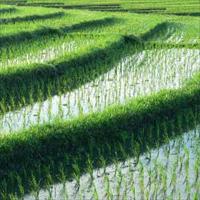AFRICA: Investment key to doubling rice production

Greater investment to double rice production in Africa is needed to reduce food insecurity as well as improve livelihoods, specialists urged.
Consumption of rice in Africa is growing faster than any crop and, according to the Africa Rice Center has done so at an average of five percent per year since 1960.
"We believe that rice can help move people out of poverty, not just food insecurity," said Namanga Ngongi, president of the Alliance for a Green Revolution in Africa (AGRA), an African-led partnership that helps small farmers boost productivity and income.
"Rice has a high potential for development in Africa as it is a tropical crop," Ngongi said. He was speaking at a regional meeting, which is bringing together specialists to consider how to double production to 28 million tonnes by 2017/2018.
"We know what we can and should do with rice. Doubling production will be difficult but it is possible," according to the Japan International Cooperation Agency. The agency plans to scale up grants, loans and technical cooperation to improve output.
Supply versus demand
Despite an increase in production in sub-Saharan Africa to 14.2 million tonnes (of paddy) in 2006 from 8.6 million tonnes in 1980, demand still outstrips supply.
In Kenya, annual production has halved to 45,000MT since 2006 due to drought, new diseases and limited access to good quality seeds and fertiliser, said Agriculture Minister William Ruto. The national demand is 300,000MT.
"Kenya does not have an active rice-breeding programme," he said. "There is an urgent need to streamline rice research to take advantage of new technologies for boosting rice productivity."
Sub-Sahara Africa is a net importer of rice, with Nigeria, South Africa, Senegal and Côte d’Ivoire ranking among the top 10 rice importers in the world.
"With nearly 40 percent of the total rice consumption of Africa coming from the international market, African national rice economies are more exposed to unpredictable external supply and price shocks than those of other continents," Papa Abdoulaye Seck, director-general of the Africa Rice Center (WARDA), said in a blog article.
"In the medium and long term, tax on all critical inputs, basic agricultural machinery and equipments and post-harvest technologies needs to be reduced," Seck said.
Quality issues
Poor uptake of improved higher-yielding rice varieties has also kept production low. "The main bottleneck for their diffusion is a lack of seeds," Moussa Sie, a plant breeder with WARDA, told IRIN. “National seed systems are non-existent or not working.
"We need to help farmers get enough quality seeds and fertiliser, and put in place mechanisms to help them sell their products," Sie said. "For that, we need to emphasise capacity-building for farmers and scientists."
Rice varieties such as NERICA (New Rice for Africa), developed by WARDA, mature quickly, are drought tolerant and some are tolerant to salinity, iron toxicity and adverse temperatures. NERICA is a cross between low-yield African rice and higher-yielding Asian rice.
"All these varieties are suitable for giving acceptable yield under low input rice production conditions," he said.
Sie said good NERICA dissemination results had been obtained in Guinea and Uganda because of political support, good partnerships among research institutions, and, in the case of Uganda, private seed companies, which are virtually non-existent in West Africa. In the past three years, Uganda has doubled rice production.
However, variety alone is not enough, according to WARDA. "Yield gaps between actual farmer yields and what is potentially possible are huge, and these cannot be closed by the variety alone. Fertiliser will be very important. A lot can also be done through better crop management without additional production costs, especially in the irrigated and rain-fed lowland systems."
An estimated 20 million hectares of rain-fed lowlands could be used for rice in Africa.
However, long-term focus should be on increasing productivity. "Land extension accounts for only 30 percent of the productivity gains," Shivaji Pandey, of the UN Food and Agriculture Organization, said. "Half of the yield improvement would be dependent on better seed varieties as well as water management and reduction of post-harvest loss."
 Back and Next - Back and Next
Back and Next - Back and Next See Also - See Also
See Also - See Also